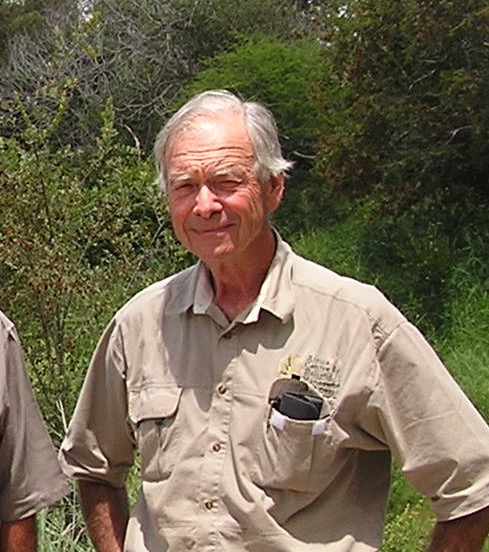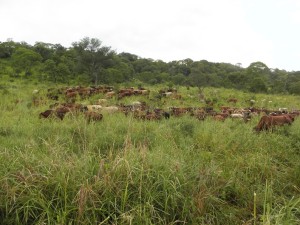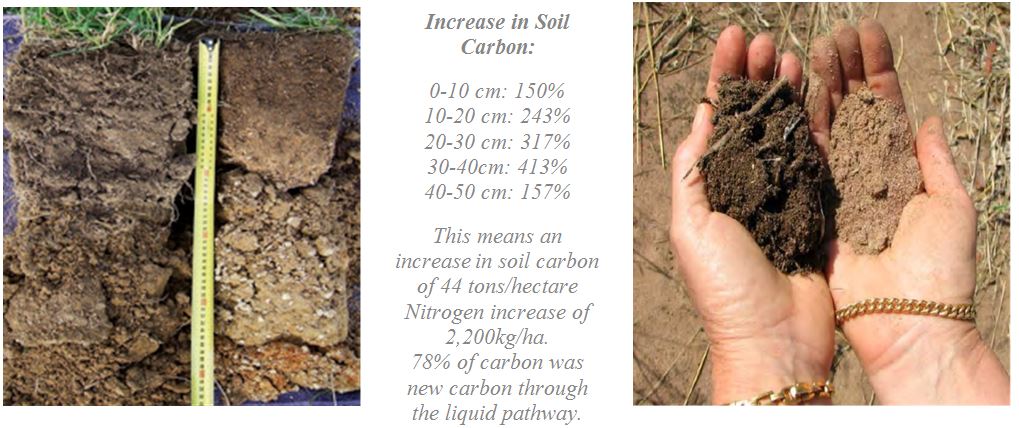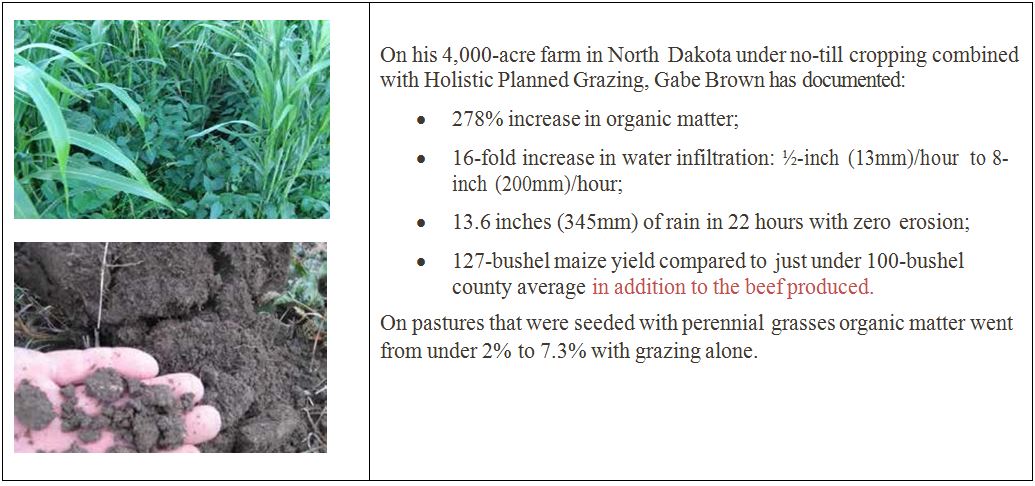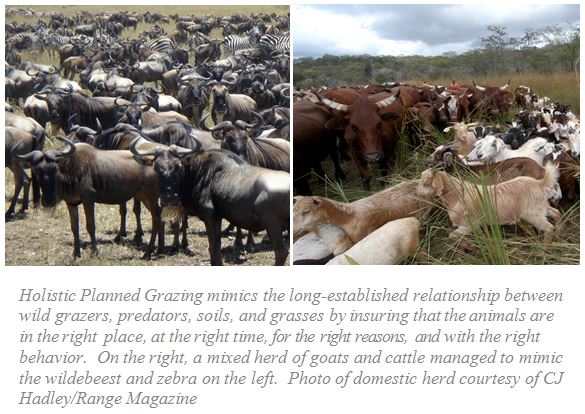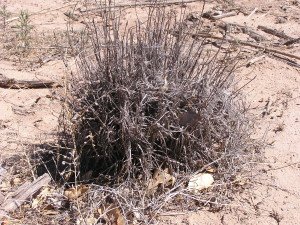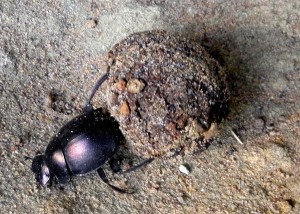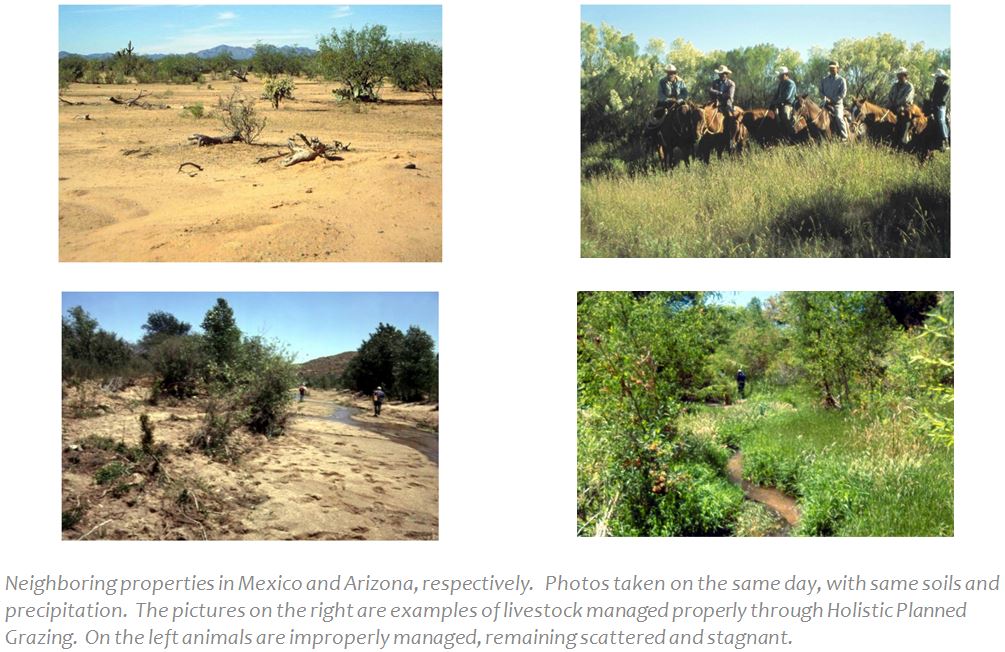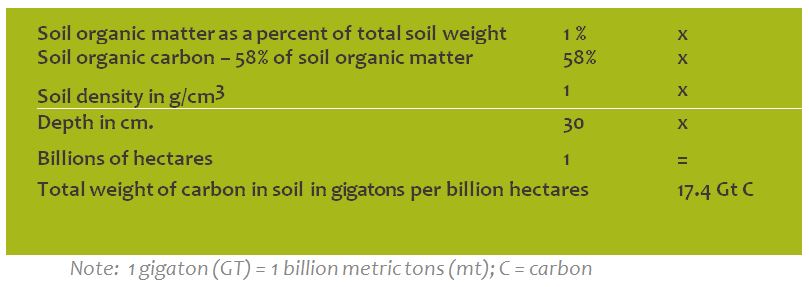Here is this issue’s GUEST ARTICLE:
CLIMATE CHANGE, HEALTHY SOILS, AND HOLISTIC PLANNED GRAZING: A RESTORATION STORY
– by Savory Institute staff (Allan Savory, Founder and President, pictured above)
SUMMARY
Regenerating the health and productivity of our soils is critical for ensuring the Earth’s climate remains conducive to not only human life but other species as well. Moreover, we need to take direct action so that we have enough water and food to sustain a growing population of people. Livestock, properly managed, have a critical role to play in achieving these goals.
Reducing fossil fuel emissions is essential for curtailing the acidification of our oceans and for reversing the rapidly increasing concentrations of carbon dioxide (CO2) and other greenhouse gases in the atmosphere. But it is just as critical that we greatly reduce the CO2 emissions tied to modern agricultural practices. In addition, there are still many billions of tons of CO2 in the atmosphere that need to be drawn down to Earth and safely stored if we are to maintain a livable climate for life on Earth.
The most obvious place to store this “legacy load” of CO2 is in our soils, where soil organisms convert it into organic matter, or soil organic carbon. The world’s soils, however, are unable to store the vast amounts of carbon they once did; scientists estimate our soils have lost up to 80 to 537 billion tons of carbon and that land misuse accounts for 30% of the carbon emissions entering the atmosphere.
Efforts to limit emissions from fossil fuel Combustion alone are incapable of stabilizing levels of carbon dioxide in the atmosphere.
Here we will shed light on the process of atmospheric carbon capture and storage that has developed in the natural world over millions of years, has minimal possibility for unintended consequences, and has myriad benefits for the health of lands worldwide as well as all dependent on them.
The quantity of carbon stored in soils is directly related to the diversity and health of soil life. Bacteria, fungi and other soil life convert carbon that plants have extracted from the atmosphere through photosynthesis into organic matter. When soils are healthy, soil life is healthy and more carbon is converted and stored.
Carbon is also temporarily stored in living plants and animals, but is released when they respire, or when they decompose – either through decay, or through oxidation as a result of burning, or the weathering of plant material unable to decay.
Grasslands, because of their sheer size – 40% of Earth’s landmass – and their inherent ability to store more carbon in their soils than any other environment, deserve special attention. Forests store more tons of carbon per hectare, but only comprise 28% of the landmass. Proper management of the wild and domestic grazers that evolved in and still inhabit the grasslands of the world will be key to recreating healthy grassland soils that can sequester more carbon.
Grasslands have been degrading for millennia, primarily due to cultivation, fires and improperly managed livestock. They are capable of supporting far greater numbers of grazing animals – wild and domestic – than currently. An effective, profitable, and culturally relevant method for increasing soil carbon is to restore the world’s grasslands to their optimal health. To accomplish this at the scale and pace needed, Holistic Management and one of its associated processes, Holistic Planned Grazing, offers a tangible way to remove much of the excess carbon from the atmosphere by restoring grassland soils to health.
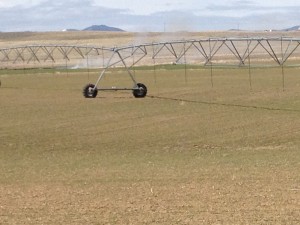 Since the 1970s, Holistic Management’s effectiveness has been well documented on millions of hectares on four continents. By restoring grasslands through Holistic Planned Grazing we have the potential to remove the excess atmospheric carbon resulting from soil loss due to agricultural practices over the past 10,000 years and of industrial-era greenhouse gas emissions. This sequestration potential, when applied to up to 5 billion hectares of degraded grassland soils, could return 10
Since the 1970s, Holistic Management’s effectiveness has been well documented on millions of hectares on four continents. By restoring grasslands through Holistic Planned Grazing we have the potential to remove the excess atmospheric carbon resulting from soil loss due to agricultural practices over the past 10,000 years and of industrial-era greenhouse gas emissions. This sequestration potential, when applied to up to 5 billion hectares of degraded grassland soils, could return 10
billion tons or more of excess atmospheric carbon to the terrestrial sink annually, thereby lowering greenhouse gas concentrations to pre-industrial levels in a matter of decades.
And we can do this while restoring agricultural productivity, increasing retention of soil water to rebuild “in-soil reservoirs,” and enhancing wildlife habitat – while also supplying high-quality protein for millions and providing jobs for thousands of people in rural communities.
INTRODUCTION
The new millennium brought growing concern about climate change, food and water security, poverty, and population growth. Atmospheric carbon dioxide levels had increased by 40% over pre-industrial levels and today stand at 400 parts per million CO2. – 50 parts per million higher than scientists believe is safe for human life. Some 850 million people go hungry every year, according to the United Nations World Food Program, and population growth is still increasing exponentially – 7.3 million in 2015 rising to 11 billion by 2100. The Millennium Ecosystem Assessment, a global report on the effects of human activity on the environment, found that food production, which is entirely dependent on a benign climate, will have to increase by 50% by 2050 to keep pace with global population needs.
Our ability to produce more food increased dramatically in the latter half of the last century because of technological innovation driven by cheap fossil fuels. However, this increased productivity has resulted in substantial damage to the global ecosystem upon which we, and all life forms, depend. This includes damage to fresh water supplies, through pollution from fertilizer runoff, over-pumping of aquifers, and mismanagement of major portions of our water catchments (the areas from which rainfall and snowmelt drain into streams or rivers).
Harmful changes in the earth’s climate have been accelerating considerably faster than the scientific community anticipated and thus the level of urgency is chronically understated and our response continues to be inadequate.
In theory, balancing the sources and sinks of atmospheric carbon dioxide can address, at least in part, human-induced climate change. However, natural sinks are decreasing because croplands, grasslands, coral reefs, and rain forests are being degraded at an increasing rate. To balance carbon dioxide flows, it is necessary both to restore and protect these environments in addition to making drastic cuts in fossil-fuel use. Efforts to limit emissions from fossil-fuel combustion alone are incapable of stabilizing levels of carbon dioxide in the atmosphere.
CARBON SOURCES AND SINKS
Carbon sources release more carbon than they store; carbon sinks hold more carbon than they release. Land management practices greatly affect this. The greatest terrestrial carbon pool – the soil – holds carbon in plant roots (biomass), microorganisms (biomass), carbon dioxide, and carbohydrates secreted from plants or microorganisms or resulting from the decomposition of dead plant or animal material. Carbon dioxide is released into the atmosphere whenever plants or soils are removed or disturbed. The amount and type of disturbance and the characteristics of the environment affect how quickly an environment can recover its carbon storing capabilities. Organisms that grow larger and are longer lived tend to store more carbon and allow more accumulation in the underlying soil. Plowing or in any way moving soil releases the CO2 stored there. Chemicals that kill soil organisms deplete their ability to contribute carbon to the soil.
Twenty-five years ago it seemed straightforward that reducing emissions would lower the amount of carbon in the atmosphere and substituting non-carbon energy sources would be both technologically feasible and culturally acceptable. Accordingly, almost all efforts to combat global warming have been directed at controlling the sources, and primarily only fossil fuel sources at that, ignoring the extensive quantities of carbon emitted from degraded soils. As a result, the emissions reduction strategy has, to date, been a decisive failure. After nearly three decades of attempts on the part of governments, non-governmental organizations, the scientific community, and citizens worldwide, not only has the total atmospheric carbon burden increased to 400 ppm the rate of increase has been accelerating:
Atmospheric CO2 is accelerating upward from decade to decade. This rate of increase from 2005-2014 is double the increase in the mid-1960-70s, and 100 times that of natural glaciation cycles. Data courtesy of co2now.org and retrieved at http://co2now.org/current-co2/co2-trend/
OTHER GREENHOUSE EMISSIONS
It’s not just CO2 that traps heat in the atmosphere, creating a greenhouse effect. Three other emissions play a major role in climate change:
- Black Carbon, per unit of mass, can absorb a million times more solar energy than carbon dioxide. It is particulate matter, rather than a gas, formed by the incomplete combustion of fossil fuels, biofuels, and biomass, and is a major component of soot. Globally, it comes from biomass burning, including wildfires (36%),* domestic/residential sources (25%), transport and industry (19% each) and energy/power/other (1%)
*Globally, wildfires burn 350-450 million hectares each year. A further 1-2 billion hectares is burned annually via hunting, agricultural and fuel reduction burns. - Nitrous Oxide gas emissions are 300 times more effective than CO2 at trapping heat in the atmosphere. They are produced by both natural and human sources. Natural sources include soils under natural vegetation and the oceans, and create 62% of total nitrous oxide emissions. Human sources include agriculture, biomass burning, fossil fuel combustion and industrial processes and are responsible for 38% of total emissions. The quantity of nitrous oxide produced by natural sources has been completely offset by natural sinks for thousands of years. But in recent years human activities have been producing emissions much more rapidly than the Earth can remove them. Nitrous oxide levels are higher today than at any other time during the last 800,000 years.
- Methane gas emissions are also produced by both natural and human sources. Natural sources contribute 36% of all methane emissions and include wetlands, which account for 78% of all naturally produced emissions, termites (12%) and the oceans (10%). Human related sources create 64% of the total and include fossil fuel production, which accounts for 33% of all human sources, intensive livestock farming** (23%), landfills and waste (16%), biomass burning (11%), rice paddies (9%) and biofuels (4%). Methane is a short-lived greenhouse gas (a single molecule lasts in the atmosphere from 9 to 15 years) that has approximately 20 times the warming potential of carbon dioxide.
** Intensive livestock farming refers mainly to factory farms and feedlots, which produce excessive sources of methane from manure lagoons and lead to land-use changes (e.g., conversion of forests and grasslands to croplands for animal feed). Healthy, well-aerated soils – a characteristic quality of grasslands under Holistic Planned Grazing – harbor bacteria called methanotrophs, which break down methane. Soil based decomposition of methane may be equal to or greater than ruminant methane production, depending on animal density, soil type and soil health. (For more information see Savory Institute’s white paper: An Exploration of Methane and Properly Managed Livestock through Holistic Management).
Since it has become increasingly apparent that emissions reductions will not take place in a reasonable timeframe, there have been alternative proposals for reducing the concentration of atmospheric CO2 and other greenhouse “gases” by actively removing them from the atmosphere. The advantages of such undertakings include the opportunity to bypass the impossibly slow international agreement processes and the possibility of succeeding in reversing global warming in spite of persistent ongoing emissions. Unfortunately, most of these proposals rely on high-tech geo-engineering schemes, which are largely untested for effectiveness, may be fraught with unintended consequences, and are potentially very expensive in direct economic costs as well as indirect environmental and social costs.
It is well known that terrestrial environments are important global carbon sinks, and no one is more committed to measuring just how much carbon various environments can sequester than Rattan Lal, Director of the Carbon Management and Sequestration Center at Ohio State University. He estimates that agricultural soils could recapture 3 billion tons of carbon from the atmosphere each year, given better soil management. And in doing that we can reverse global warming. He has been working with scientists on test plots around the world to develop ways to measure the amount of carbon sequestered in soils, primarily in croplands and forests. However, croplands make up only 11% of Earth’s landmass and forests, 28%. Grasslands comprise 40% of Earth’s landmass and store more carbon in soils than any other environment, although forests store more tons per hectare. Thus, grasslands have the potential to sequester more carbon, and perhaps more cost effectively and quickly with the help of the wild and domestic grazers that inhabit them.
CARBON SEQUESTRATION
Carbon sequestration means that carbon is held in storage rather than released to the atmosphere as CO2. A grassland, for instance, stores carbon over the course of a month to years as biomass, yet this carbon is also released through plant and animal respiration. In this same grassland, however, stored carbon may eventually become stable soil carbon, creating the soil structure that promotes water retention and underpins the resilience and productivity of our global ecosystem. This carbon can be sequestered for thousands of years before release. When climate scientists refer to carbon sequestration, they include both the carbon held in living organisms (biomass) and that stored in soils. In general, the carbon stored in soils is much greater than that stored in vegetation. For example, the Intergovernmental Panel on Climate Change (IPCC) estimates that 9 billion tons of carbon is held in grassland vegetation while 295 billion tons is stored in grassland soils.
At least one billion people depend on grasslands for their livelihoods, mostly through livestock production for food and fiber. Therefore, there are huge economic and social costs associated with the degradation of grasslands apart from the diminished role they are able to play in sequestering carbon. In this view of the world from space, we’ve circled the areas of the world’s grasslands and deserts, most of which were formerly grasslands. In the vast region extending across North Africa – the former granary of the Roman Empire – through to China and India, 5% at best can grow crops. The remaining 95% can only feed people from livestock.
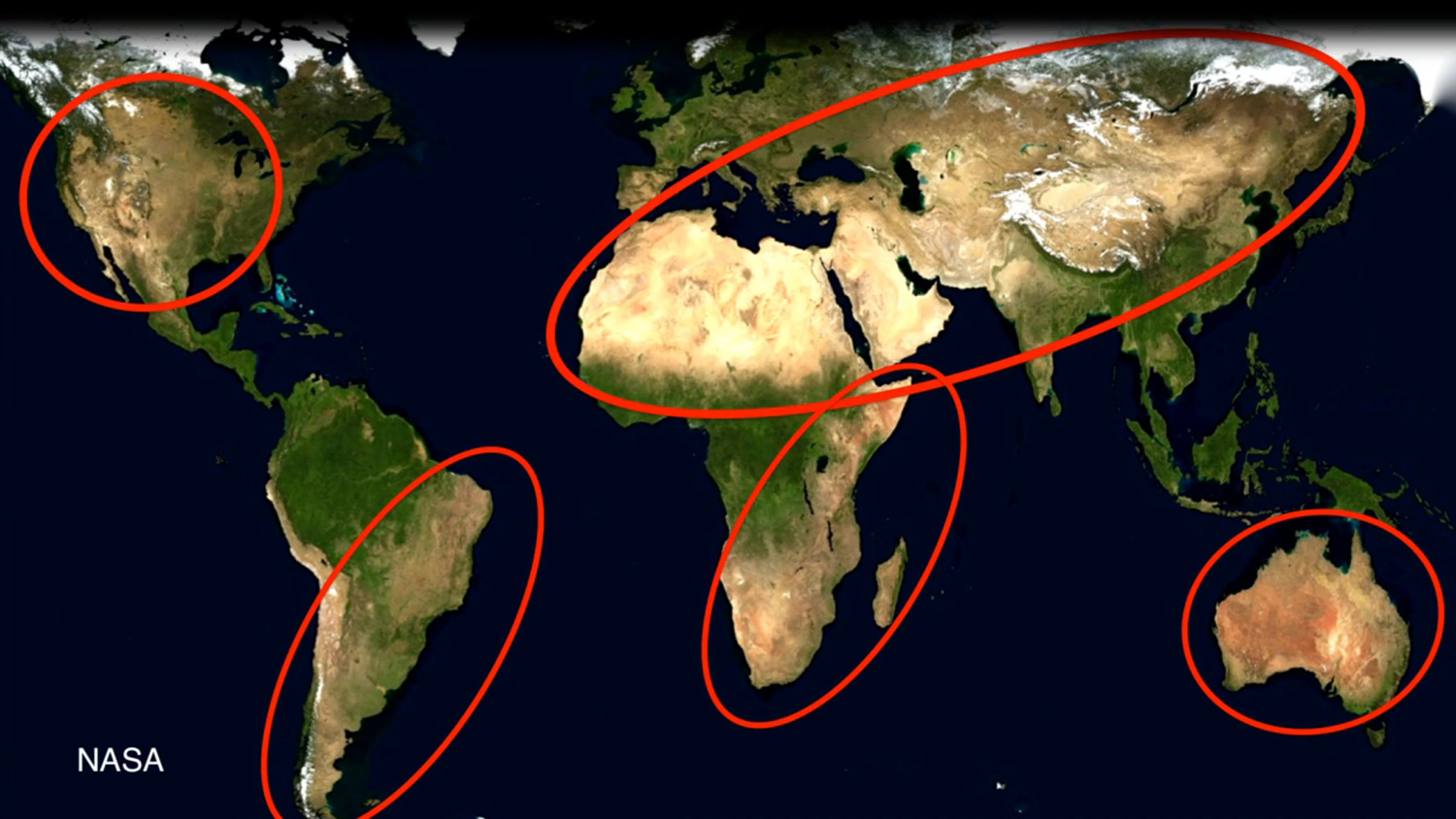
Although many attempts have been made to adopt technical solutions to reverse grassland degradation, most require large amounts of capital and expensive technology involving energy inputs from unsustainable sources, are culturally inappropriate, have not been successful in creating large-scale, sustained improvements to the landscape.
The good news is that livestock managers from around the world are demonstrating that properly managed livestock can restore degraded grasslands with minimal capital and low energy inputs and within their own culturally-relevant context. To achieve restoration and sustain it worldwide requires low-input technology plus decision-making and management procedures that readily adapt to the local context, as these land managers have shown. In essence, they have changed the way they make decisions so that they achieve ecological restoration while enhancing their livelihoods and quality of life. The management focus is not so much on creating healthy soils as on enhancing ecological functioning – improving the effectiveness of water and mineral cycles, increasing solar energy flow to maximize photosynthesis, and enhancing community dynamics (biodiversity). The key to enhancing them all is ensuring soils remain covered year round. When soils remain covered, soil life thrives and more carbon is sequestered. Grazing animals properly managed provide that soil cover by grazing, but not overgrazing, and trampling down dying grass leaves to provide soil-covering litter.
Unfortunately, most climate change advocates resist – often fiercely so – the idea of using grazing animals, particularly livestock, to sequester carbon in soils. There are several reasons for this:
- Misunderstanding of the capacity of grassland soils to sequester carbon;
- Ignorance of the extent of carbon emissions from soil loss through human activity over millennia;
- Lack of understanding of the extent and potential of grasslands to be a carbon sink (it is for good reason that the world’s great grain-growing regions were formerly deep, carbon-rich grassland soils;
- The degradation caused by improperly managed livestock; and,
- The almost exclusive attention to emissions reductions.
An enhanced understanding of how grassland soils function and the role grazing animals can play in rebuilding them to enhance their carbon storing capacity may begin to turn this troubling situation around.
THE LIFE OF GRASSLAND SOILS
In healthy soils carbon is stored in stable complex biomolecules, such as lignin and glomalin, which remove carbon from the atmosphere and store it in the soil for hundreds or even thousands of years.
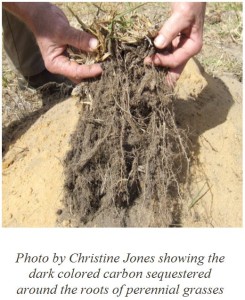 When grazing animals eat perennial grasses, the root systems die back and become feed for communities of bacteria, leaving porous passages and carbon-rich biomolecules that are aggregated into a sticky substance called humus. When the animals move on, the root systems regrow along with the aboveground leaves. The process repeats itself when the regrown perennial grass is grazed again, increasing soil porosity, water and carbon content annually. Lignin, glomalin, and protein fragments from root dieback, along with humus created by bacterial action comprise the process of humification, which is part of the liquid carbon pathway. Humus is critically important in water retention, balancing minerals, and adjusting pH and is why healthy soils are dark in color relatively low in density, and clump, rather than crumble, when handled.
When grazing animals eat perennial grasses, the root systems die back and become feed for communities of bacteria, leaving porous passages and carbon-rich biomolecules that are aggregated into a sticky substance called humus. When the animals move on, the root systems regrow along with the aboveground leaves. The process repeats itself when the regrown perennial grass is grazed again, increasing soil porosity, water and carbon content annually. Lignin, glomalin, and protein fragments from root dieback, along with humus created by bacterial action comprise the process of humification, which is part of the liquid carbon pathway. Humus is critically important in water retention, balancing minerals, and adjusting pH and is why healthy soils are dark in color relatively low in density, and clump, rather than crumble, when handled.
Soil organic carbon constitutes approximately 60% of soil organic matter. It has beneficial effects on the chemical, physical, and biological functions of soil quality, increases water-holding capacity, and contributes to soil structural stability. Soil organic matter increases absorption of nutrients, including trace elements important to plant growth, prevents nutrient leaching; and is integral to the organic acids that make minerals available to plants. Organic matter also buffers soil from strong changes in soil pH (acidity). Consequently, it is widely accepted that the carbon content of soil is a major factor in overall soil health, plant production, and the health of water catchments as well as being a sink for atmospheric carbon to offset climate change.
STORED CARBON = STORED WATER
Every gram of additional carbon sequestered as stable organic matter can potentially lead to the retention of up to 8 grams of additional soil water, to rebuild the “in-soil reservoir” capacity of grassland soils. Certain types of soil organic matter can hold up to 20 times their weight in water.
The extremely complex and symbiotic functions of these soil life forms cannot be replaced with synthetic chemistry, which, on the contrary, eventually lead to massive soil erosion and wholesale loss of stored carbon to the atmosphere. Conventional agriculture that uses synthetic fertilizers and pesticides, as well as improperly managed livestock, destroys essential soil organisms and leads to widespread soil degradation. It is well known that such soils become “addicted” to artificial inputs, requiring larger and larger “fixes” over time while yielding diminishing outputs.
PASTURE CROPPING
Innovative farmers in Australia have managed to utilize grasslands that are marginal for crop production, due to low and unreliable rainfall, to produce rain-fed crops at least one year in three with minimal inputs and without disturbing or exposing the soil. These leading farmers are able to harvest 1-2 tons per hectare of grain, even on sands receiving less than 150mm (6 inches) of rainfall, restoring soil structure, and thus its water-holding capacity, by drilling grain seed directly into perennial grassland that has been grazed by livestock under Holistic Planned Grazing. Once the grain is reaped the pasture can be grazed again. Due to the continuous grass root growth and microbial activity, soils under pasture cropping can sequester carbon into soils at rates of up to 10 tons of carbon per hectare per year in contrast to soils under standard crops that often lose soil carbon, even with limited tillage and stubble mulching.
Initially in this neighboring, paired site comparison in Australia, parent material, slope, aspect, rainfall, and farming enterprises, as well as soil carbon in both were originally the same. On the left, the 0–50 cm (0-20 inch) soil profile is from a pasture in which groundcover has been actively managed (no-till cropped and holistically grazed) to enhance photosynthetic capacity. On the right, the 0–50 cm (0-20 in) soil profile is from a conventionally managed neighboring property (10 m/30 ft through the fence) that has been set-stocked and has a long history of phosphate application. While the carbon levels in the 0–10 cm (4 in) increment are very similar (this surface carbon results from the decomposition of organic matter (leaves, roots, manure, etc.) forming short-chain unstable “labile” carbon, the carbon below 30 cm (12 in) in the left hand profile has been sequestered via the liquid carbon pathway. – Photo and Research: Christine Jones.
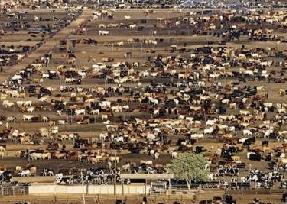 In terms of livestock production, the modern industrial approach to animal husbandry, including grain-feeding cattle in gigantic feedlots has so distorted society’s idea of what it means to raise cattle and other grazing animals that many do not understand how essential they are in creating healthy grassland when properly managed. For when grazers remain bunched in response to predators, and keep on the move to avoid feeding on ground fouled by their own wastes, they aerate, fertilize, and restore the soils. [Pictured here: A typical, modern way to raise beef in feedlots.]
In terms of livestock production, the modern industrial approach to animal husbandry, including grain-feeding cattle in gigantic feedlots has so distorted society’s idea of what it means to raise cattle and other grazing animals that many do not understand how essential they are in creating healthy grassland when properly managed. For when grazers remain bunched in response to predators, and keep on the move to avoid feeding on ground fouled by their own wastes, they aerate, fertilize, and restore the soils. [Pictured here: A typical, modern way to raise beef in feedlots.]
This is the opposite of what occurs under conventional grassland management where livestock that do not fear predators and thus spread out, graze randomly over the same area day after day, overgrazing some plants, allowing others to over-rest, compacting soils in some areas, hardly disturbing them in others.
REST, FIRE, AND GRASSLAND HEALTH
In response to the degradation of grassland habitats conventional wisdom prescribes rest—that is, removal of animals for years or even decades. However, in the seasonally humid, or “brittle” environments, which comprise 75% of all grasslands on the planet, rest is destructive not restorative, and despite clear evidence, rest remains firmly entrenched in the dominant paradigm. In these environments especially, being grazed is necessary for the health of most perennial grasses, which, in evolutionary terms, may be why they, unlike trees, never developed an ability to remove their dead leaves at the end of the growing season. The animals needed the standing dead plant material as feed through months of no growth just as much as the grass needed the animals to remove that old growth to allow for fresh growth in the coming season from growth points close to the ground.
When these grasses are left ungrazed they will begin to weaken, and in a few years turn grey and begin to die from overrest. Soils in these environments also suffer from overrest when animals are not present or if they are present but not bunching as they would under threat of predation. The photo to the left shows an overrested plant surrounded by overrested soil in a riverine nature preserve in New Mexico that hasn’t had grazing animals on it in over 50 years. Nearly all the grass plants are dead and turning grey due to oxidation, as there is no life present that can assist in decay. Very few new plants are germinating on the undisturbed soil surrounding this grass plant.
In perennially humid environments, such as those in Northern Europe or tropical rainforests, rest is restorative, mainly because dead plant material breaks down fast through decay assisted by insect and microorganism activity. These environments did not evolve with large herds and the pack-hunting predators that caused them to remain bunched.
Resting the land either totally or partially (reducing animal numbers and changing their behavior) degrades the seasonally humid brittle environments. To keep grass plants healthy when too few or no grazing animals are present, people have traditionally burned them to remove the dead stems and leaves and promote new growth. But this has unfortunate side effects: fire is nothing more than rapid oxidation, which quickly turns vegetation (biomass) into CO2, nitrous oxide, methane and black carbon. But equally important, it exposes soil and that makes rainfall less effective because it runs off more easily and evaporates more quickly.
Livestock properly managed, minimize the need for burning, as well as the frequency and severity of wildfires. The disturbance they provide stimulates biotic activity by facilitating circulation of oxygen, carbon dioxide and other gases, by providing nutrients, by allowing penetration of water, and by providing plant litter cover to minimize or eliminate bare ground. Most important, in fact, is to cover the ground with dung and trampled grass which holds water in the soil, thereby raising the effectiveness of the rainfall. Grassland biodiversity both above and belowground flourishes as the area of bare soil diminishes. Thus, ruminants are organs as essential to living grasslands as stomachs
and hearts are to mammals.
HOLISTIC PLANNED GRAZING: MAKING GRASSLANDS WHOLE AGAIN
Although many grassland environments have been badly degraded, it is possible to manage livestock in a way that reverses this trend. Well-managed grasslands have a very important role to play globally as providers of livelihoods, water catchments, in-soil water reservoirs, and diverse habitat for a multitude of plants and animals. In addition, they hold a large reserve of soil carbon which, when released through soil degradation, contributes to carbon dioxide emissions. However, under restorative management degraded grassland can enhance soil carbon sequestration.
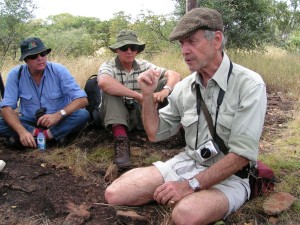 An innovative biologist from Zimbabwe named Allan Savory pioneered Holistic Management and its planning process, Holistic Planned Grazing. Thanks to Savory and others, for decades we have been learning how to restore grasslands by mimicking nature. In fact, the synergistic nature of eco-restoration is a prominent theme in Holistic Management. The process involves re-establishing the evolutionary relationships between grazing animals and their habitats. Successful conservation-minded grassland managers practicing Holistic Management enhance the health of their land as well as improve their profitability and quality of life. This is done while simultaneously providing food for people and ecosystem services desired by society through building soil, water, and plant resources.
An innovative biologist from Zimbabwe named Allan Savory pioneered Holistic Management and its planning process, Holistic Planned Grazing. Thanks to Savory and others, for decades we have been learning how to restore grasslands by mimicking nature. In fact, the synergistic nature of eco-restoration is a prominent theme in Holistic Management. The process involves re-establishing the evolutionary relationships between grazing animals and their habitats. Successful conservation-minded grassland managers practicing Holistic Management enhance the health of their land as well as improve their profitability and quality of life. This is done while simultaneously providing food for people and ecosystem services desired by society through building soil, water, and plant resources.
Holistic Planned Grazing combines scientific principles with local knowledge to positively influence four fundamental processes at work in any ecosystem:
- Efficient capture of solar energy by plants, otherwise known as energy flow;
- Minimizing evaporation and runoff and maximizing in-soil water reservoirs, through an effective water cycle;
- Optimal cycling of nutrients through an effective mineral cycle; and
- Promotion of high biodiversity with more complex mixtures and combinations of species, otherwise known as community dynamics.
The Holistic Grazing Plan identifies when and how long the animals will be in any given area and what they will do while they are there, such as trample bare soil patches to help them grass over more quickly, or take down the forage in an area prone to wildfires.
All of this is planned in a step-by-step process recorded on a chart that refers to a map on which grazing divisions have been identified (as shown at right – in this case in a village in Zimbabwe). These divisions are relatively small and created with permanent or temporary electric fence, or when animals are herded, by agreeing on landmarks that bound specific areas. The plan ensures an adequate recovery period from when a plant is grazed until grazed again and when soil is trampled and trampled again. While animals are in one division, all the other divisions are recovering from having been grazed and trampled.
Both grazing and trampling are routinely monitored and timings adjusted if needed. This feedback loop is an essential element of Holistic Management: managers plan (and assume the original plan may be wrong), monitor the plan, control (make adjustments as necessary), replan, if necessary, and again monitor and control.
Managers plan twice a year – at the onset of the growing season, and again at the onset of the non-growing season. In the growing season, once a plant has been bitten its roots and leaves need time to regrow and that time can be anywhere from 30 to 90 days, which becomes the recovery period. If bitten again before they’ve had time to recover they will be overgrazed. At the end of the growing season annual grasses all die. The aboveground leaves and stems of perennial grasses also die but before doing so they translocate energy to the plant base and roots that will be used to send up new leaves in the next growing season. Because they aren’t growing, or only growing very slowly, the plants won’t be overgrazed and so recovery periods aren’t as necessary to plan in the nongrowing season. But the animals perform much better if they continue to move off ground they have fouled with their own dung and urine and don’t return to the same piece of ground more than a few times before the new growing season starts. So the number of times they graze each division is the focus of the planning.
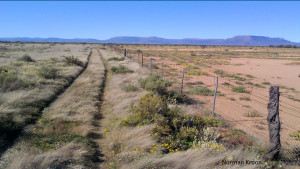 By using the tools of grazing and animal impact and paying attention to adequate plant recovery, measurable recovery of the land begins within the first year and, in as few as three years, many long-disabled processes come back to life. For example, insects such as dung beetles return. They retrieve ruminant dung and store it more than 18 inches (45 cm) beneath the surface creating new soil and storing carbon in the process. Worms and small mammals such as moles and prairie dogs churn the soil, while deep-rooted perennial grasses regrow and create channels for water and gases. Mycorrhizal fungi, with literally thousands of miles of hyphae in a small patch, transport nutrients they obtain from soil minerals and exchange them for carbohydrates from photosynthesizing plants. The fungi synthesize a stable glycoprotein – glomalin – that holds 4 to 20 times its weight in water. Microorganisms join the elaborate fray, and in the process create complex carbon molecules that store carbon deep in the soils for a long period of time. These are the healthy soils and biodiversity that Holistic Managers throughout the world strive to recreate, capturing carbon, providing food, re-establishing effective water and mineral cycles, and imparting beauty to the land (see below).
By using the tools of grazing and animal impact and paying attention to adequate plant recovery, measurable recovery of the land begins within the first year and, in as few as three years, many long-disabled processes come back to life. For example, insects such as dung beetles return. They retrieve ruminant dung and store it more than 18 inches (45 cm) beneath the surface creating new soil and storing carbon in the process. Worms and small mammals such as moles and prairie dogs churn the soil, while deep-rooted perennial grasses regrow and create channels for water and gases. Mycorrhizal fungi, with literally thousands of miles of hyphae in a small patch, transport nutrients they obtain from soil minerals and exchange them for carbohydrates from photosynthesizing plants. The fungi synthesize a stable glycoprotein – glomalin – that holds 4 to 20 times its weight in water. Microorganisms join the elaborate fray, and in the process create complex carbon molecules that store carbon deep in the soils for a long period of time. These are the healthy soils and biodiversity that Holistic Managers throughout the world strive to recreate, capturing carbon, providing food, re-establishing effective water and mineral cycles, and imparting beauty to the land (see below).
CALCULATING SOIL CARBON SEQUESTRATION POTENTIAL
When looking at the potential for soils to sequester carbon the discussion and research has focused almost solely on soils that already exist. These are geological in origin and accumulate slowly over thousands of years. Very little attention has been paid to new biological soil that can be created rapidly under Holistic Planned Grazing. This oversight has led to a dramatic underestimation of soil sequestration capacity by an as yet unknown but potentially significant magnitude.
NEW SOIL CAN BE CREATED RAPIDLY
The rates of soil formation provided in the scientific literature usually refer to the weathering of parent material and the differentiation of soil profiles. These are extremely slow processes, sometimes taking thousands of years. Topsoil formation is a separate process to rock weathering and can occur quite rapidly under appropriate conditions. In fact, soil building occurs naturally in most terrestrial habitats unless reversed by inappropriate human activities, or prevented by lack of disturbance [i.e., grazing]. If the land management is appropriate, evidence of new topsoil formation can be seen within 12 months, with quite dramatic effects often observed within three years.
Since most of mainstream soil and rangeland science has yet to seriously investigate the biological creation of soils, we currently have to rely mostly on the experience of practicing farmers and ranchers and some pioneering researchers both in and out of academia to estimate soil carbon sequestration potential.
For calculation purposes a discussion of soil characteristics is in order. First of all, what we call mineral soil has a higher bulk density (is more compact) than biologically created soil, and is far more easily eroded. Soil loss figures usually assume an average bulk density (weight per unit volume) of around 1.4 g/cm3. One millimeter of eroded soil (about the thickness of a 5-cent coin) represents about 14 metric tons/hectare (mt/ha) soil loss. When new topsoil is forming, it will have better structure and will contain more air and more pore spaces than degraded soil, so the bulk density will be less. That is, a given volume of new topsoil will weigh less than an equal volume of mineral soil. The bulk density of healthy topsoil may be as low as 0.5 g/cm3. In practical terms, a one-millimeter increase in the height of new soil would equate to the formation of around 5–10 mt/ha of organically enriched topsoil. Therefore, for our estimations we will make a reasonable assumption of bulk soil density in healthy biological soils of 1g/cm3.
Since there are 1 x 108 cm2/ha to a depth of 1 cm, we have 1 x 108 g of soil per hectare, or 100 mt/ha. Soil organic matter will vary according to soil characteristics but soil scientists generally estimate it to be 58% of soil organic matter (SOM), which we will use in our examples. If we reasonably calculate that 1% of total topsoil weight is composed of soil organic matter, then the weight of soil organic matter will be:
To calculate the quantity of carbon captured from the atmosphere and stored in organic molecules in the soil in terms equivalent to those used by climate advocates, the equivalent formula is expressed as follows:
That is, at a standard soil measurement depth of 30 cm (1 ft), we would have a total soil carbon weight of 17.4 billion metric tons (Gt) of carbon (C) captured per billion hectares. Or, in terms of atmospheric carbon dioxide, 8.7 parts per million (ppm). This does not account for the greater and more stable carbon accumulation in the soils, up to 4 meters (12 feet) deep, which is created by the interactions of plant roots, mycorrhizal fungi, bacteria, small mammals, and insects, which in turn increase as degraded soils are restored. Soil scientists estimate that the amount of carbon stored in the top 30 cm (1 ft) of soil globally is about 70 gigatons, but increases to about 2,400 gigatons when you go down to 200 cm (7 ft), as many healthy, perennial grass roots do.[36]
THE DEEPER WE MEASURE, THE MORE CARBON WE FIND
It is crucial to note that in our measurements we may not have explored soils nearly deep enough to have an adequate understanding of the extent of carbon soil sequestration possibilities. As much as three-quarters of the mass of plants is below ground. Roots grow to well over 2 meters (6 ft.) in depth, with interesting and complex interrelationships among different life forms— grasses, forbs, and shrubs. Thus, assumptions about the ability of soil to store carbon may vary by greater than threefold depending on soil depths sampled in a study, especially considering that deeper stores of carbon are more stable and removed from the cycling carbon pool for hundreds or thousands of years. These differences take on even greater significance in restoring degraded and desertified grasslands over a period of years, since deep-rooted grassland plants may store carbon to depths of greater than 2.5 meters (8 feet) to almost 5 meters (16 feet) in depth.[37]
Just to explore the potential possibilities very conservatively, here is an example applying the formula above to a soil in which we double the soil organic matter to 2%, keep soil organic carbon at 58%, and density at 1 g/cm3, but then extend our sample an additional 10 cm down to 40 cm. The carbon captured per 1 billion hectares of grasslands would now be 46.4 gigatons of carbon.
If we were to capture 2.5 metric tons of carbon per hectare per year on the roughly 5 billion hectares of grasslands worldwide, we would remove 12 gigatons of carbon from the atmosphere every year. If gross soil sequestration is approximately 6 ppm/year, after subtracting current net annual carbon emissions of 2.5-ppm/year, net sequestration would be 3.5 ppm per year. In principle, this would return us to pre-industrial atmospheric CO2 levels in less than 40 years. The absolute validity of these numbers is not completely known, since the bases for them have yet to be fully vetted. Nor do we yet know the effects on the total amount of CO2 that may be released from melting permafrost and damaged seabed sinks. However, it is apparent that current perspectives on the amount of carbon that can be sequestered in soils are far too limited. For instance, in early 2015, scientists reported that improved grazing practices on dairy pastures in the Southeastern U.S. could capture up to 8 billion metric tons of carbon per hectare (3.6 tons/acre) each year. This argues for a much more promising outlook on the potential of grasslands to store carbon. And because we would be aligning with natural processes in sequestering carbon within grassland soils, the likelihood of unintended negative consequences is minimal.
HOW TO SEQUESTER ALL PAST AND CURRENT FOSSIL FUEL EMISSIONS
Scientists disagree on the extent of the historic loss of carbon from soils since the advent of agriculture 10,000 years ago. We included a range of estimates at the beginning of this paper, starting with Rattan Lal’s estimate of 80 billion tons because it is conservative and his methods for measuring generally accepted. Other scientists give much higher estimates, due in part to different forms of measurement and to defining agricultural lands as cropped lands only. Dutch soil scientist Piet Buringh, who measured by remote sensing, provided the high-end estimate of 537 billion tons. This is the equivalent of 218 parts per million (ppm) that was once safely stored in the ground instead of in the atmosphere, and that is roughly twice the excess carbon that we have injected into the atmosphere since 1750 (half of which was absorbed by the ocean and other carbon sinks). So if we use Buringh’s estimate, we need only put 224 billion tons (112 ppm) back into the ground, even though a percentage of the excess did not come from soil, but from burning of fossil fuels. That means that replacing just half of the soil carbon we have lost in the past 10,000 years has the potential to reduce atmospheric carbon to a preindustrial 280 ppm. Note that in so doing, we would also sequester all past and current emissions from fossil fuels.
CONCLUSION
Livestock are essential to creating healthy grasslands and a livable climate. They must, however, be raised in accordance with nature’s rules. They become part of the problem when raised on factory farms and feedlots or grazed unbunched and continuously on large tracts of land.
Obstacles to reestablishing the evolutionary grassland–grazer relationship for long-term sequestration of carbon in soils and for restoring atmospheric carbon dioxide to preindustrial levels include assumptions based on traditional livestock mismanagement, such as:
- Grazing animals chronically overgraze rangelands and destroy soils, which must be “rested” to be restored;
- Grasslands must be burned to sustain their health and productivity;
- Climate action should be focused on reducing emissions;
- Soils are a limited carbon sink, and new biologically generated soils are not part of the equation; and,
- Soil sequestration of carbon is only significant in the first 30 cm, and soil carbon cycles through the atmosphere in 25 years or less.
These assumptions can be addressed by measuring carbon in soil roots, mycorrhizae and bacteria and as humus in grasslands under Holistic Planned Grazing. While this data is still scarce, Savory Institute is working with an advisory team of senior scientists who will continue to review sampling methodology and results so they can one day soon provide scientifically robust estimates of soil carbon increases in grasslands under Holistic Planned Grazing. Nonetheless, as we have shown in this white paper, there is reliable evidence already to suggest that an alternate grazing/soil-carbon paradigm is credible. The current paradigm is preventing widespread implementation of management that has already demonstrated that ecosystem function can be restored on grazing lands. This restoration, because it positively affects carbon – and water – sequestration will almost certainly mitigate, quite possibly significantly, the human-generated atmospheric carbon burden.
In order to realize the potential hope that the grasslands of the world provide for us, we need to make the following shifts in perspective, which underlie Holistic Management:
- In Nature, everything is connected to everything else. Climate change is more than a carbon or greenhouse emission problem; it is a problem of how humans are living on Earth. We can start to address that by defining and working within a holistic context that describes how we want our lives to be, based on what we value most; what we have to produce to live lives like that; and how we and the land that supports us have to be to sustain what we produce forever.
- Nature is self-organizing, and when our ecosystem is functioning well, with effective water and mineral cycles, maximum energy flow, and biologically diverse communities, ecosystem health is the norm, not the exception. There have been significant geophysical events, such as glaciations and volcanic eruptions, and biological changes, such as major extinctions, sometimes linked to them, and these are exceptions that have altered the conditions affecting life many times throughout Earth’s history. Nonetheless functional, resilient states of ecosystem health have been the prevalent condition under which living creatures have evolved and thrived, and are key to achieving a livable climate for us.
- Healthy soil is a complex collection of interdependent life forms that may become seriously impaired when any of its elements is compromised or destroyed, as currently occurs worldwide with chemical agriculture, mismanagement of grazing animals, overrest and biomass burning/wildfires.
- Effective eco-restoration, of which Holistic Planned Grazing is an essential component, can restore grasslands and stabilize carbon levels in the atmosphere to mitigate the adverse and lethal effects of global warming.
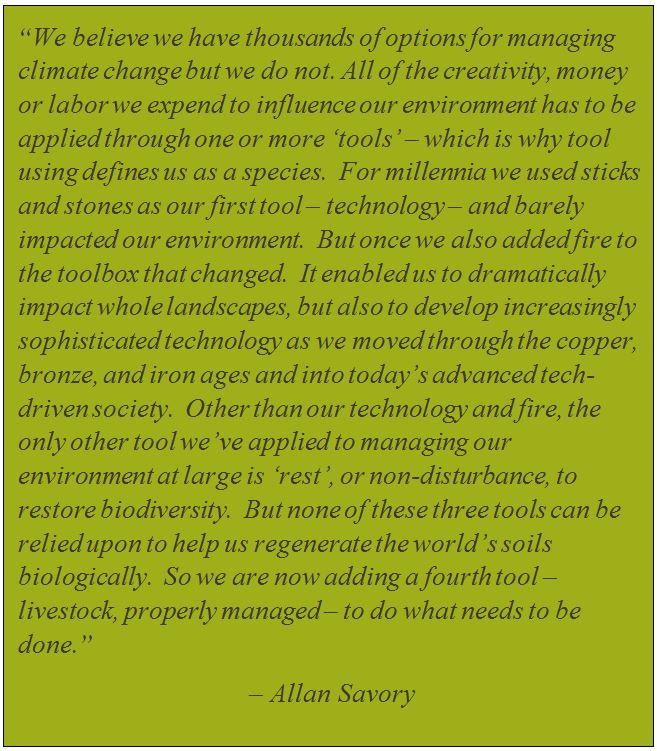 Since the advent of agriculture, humanity has been moving carbon in the wrong direction—out of the soils and into the atmosphere. Modern farming practices and mismanaged livestock may leave land bare for much of the year, exposing soil life and humus to sunlight, desiccation, and oxidation. On bare ground, photosynthetic energy necessary for humification is not harvested. We make matters worse by using synthetic fertilizers and thereby: a) seriously inhibiting the flow of energy to fungi that make stable, carbon-sequestering molecules; and, b) stimulating growth in bacterial populations destructive to soil fungi. Fire also exposes soil, can destroy soil organic matter, and emits carbon into the atmosphere. And of course, we emit massive amounts of carbon from burning fossil fuels. Our decisions to engage in these practices may have seemed right at the time, but now we know they are leading us to a soil and climate catastrophe.
Since the advent of agriculture, humanity has been moving carbon in the wrong direction—out of the soils and into the atmosphere. Modern farming practices and mismanaged livestock may leave land bare for much of the year, exposing soil life and humus to sunlight, desiccation, and oxidation. On bare ground, photosynthetic energy necessary for humification is not harvested. We make matters worse by using synthetic fertilizers and thereby: a) seriously inhibiting the flow of energy to fungi that make stable, carbon-sequestering molecules; and, b) stimulating growth in bacterial populations destructive to soil fungi. Fire also exposes soil, can destroy soil organic matter, and emits carbon into the atmosphere. And of course, we emit massive amounts of carbon from burning fossil fuels. Our decisions to engage in these practices may have seemed right at the time, but now we know they are leading us to a soil and climate catastrophe.
Today we are in the early stages of understanding the extent to which soils can sequester atmospheric carbon. It seems clear, however, that improper management of livestock and the soil sequestration models based on it have led us to underestimate significantly the potential for reversing climate change by restoring grassland soils to health. As a result, few see that restoring the evolutionary relationship between grazing animals and their grassland habitat is an essential part of the equation to restoring the carbon balance in our atmosphere so that we have a livable climate. While there are other potential methods for restoring carbon in soils, none have so many associated benefits, not the least of which is that Holistic Planned Grazing, by producing meat and other marketable products, generates income and food for local communities, requires minimal short-term investment after which it is potentially self-supporting, needs no new or complex technology and is sustainable in the long term. Given these benefits from proper grazing and grassland management even though there is uncertainty on how much carbon grassland soils can store, it just makes sense to get moving now.
NOTES
[1] Rattan Lal estimates soil carbon loss since the dawn of agriculture at 80 billion tons in: Lal, R., 2008b. Sequestration of atmospheric CO2 in global carbon pools. Energy & Environmental Science 1, 86–100.Earlier, in 1984, Dutch soil scientist Piet Buringh, using remote sensing, put total soil carbon losses since the dawn of agriculture at 537 billion tons, in Buringh, P., 1984. Organic carbon in soils of the world. In: G.M. Woodwell (ed.), The Role of Terrestrial Vegetation in the Global Carbon Cycle: Measurement by Remote Sensing, John Wiley & Sons Ltd., http://dge.stanford.edu/SCOPE/SCOPE_23/SCOPE_23_3.1_chapter3_91-109.pdf
Scheer and Sthapit estimate 30% of greenhouse gas emissions are from land misuse in: Scheer, S.J. and S. Sthapit. 2009. “Worldwatch Report #179: Mitigating Climate Change Through Food and Land Use, Worldwatch Institute, Washington, DC, 50 pp.
[1] White, R. et al., Pilot Analysis of Global Ecosystems: Grassland Ecosystems, World Resources Institute, Washington, DC, 2000, p. 51 [1] Hansen, J., M. Sato, P. Kharecha, D. Beerling, R. Berner, V. Masson-Delmotte, M. Pagani, M. Raymo, D.L. Royer, J.C. Zachos. 2008. “Target Atmospheric CO2: Where Should Humanity Aim?, Open Atmos. Sci. J. vol. 2, pp. 217-231. [1] Millennium Ecosystem Assessment. 2005. Ecosystems and Human Well-Being: Biodiversity Synthesis. Washington, DC: World Resources Institute. [1] Carey, J. 2012 “Global Warming: Faster Than Expected?” Scientific American. (November): 50-55 [1] Goreau, T.J. 1992. “Control of Atmospheric Carbon Dioxide.” Global Environmental Change 2(1): 5-11. [1] Peterman, W. Conservation Biology Institute, Corvallis, Oregon, March 4, 2015. Retrieved from: http://www.researchgate.net/post/Is_it_is_fine_to_define_the_natural_carbon_cycle_in_terms_of_carbon_sequestration [1] NOAA. 2015. Carbon Dioxide Annual Means (January). Retrieved from ftp://ftp.cmdl.noaa.gov/ccg/co2/trends/co2_annmean_mlo.txt [1] Lamarque J.F., Bond T.C., Eyring V., Granier C., Heil A., Klimont Z., Lee D., Liousse C., Mieville A., Owen B., Schultz M.G., Shindell D., Smith S.J., Stehfest E., Aardenne J.V., Cooper O.R., Kainuma M., Mahowald N., McConnell J.R., Naik V., Rishi K., and Vuuren D.P.v. (2010) Historical (1850-2000) gridded anthropogenic and biomass burning emissions of reactive gases and aerosols: methodology and application. Atmospheric Chemistry and Physics, 10, 7017-7039 [1] IPCC. Summary for Policymakers. In: Climate Change 2007: The Physical Science Basis. Contribution of Working Group I to the Fourth Assessment Report of the Intergovernmental Panel on Climate Change. Cambridge University Press, Cambridge, United Kingdom and New York, NY, USA, 2007. [1] Bousquet, P., S. C. Tyler, P. Peylin, G. R. Van Der Werf, C. Prigent, D. A. Hauglustaine, E. J. Dlugokencky, J. B. Miller, P. Ciais, J. White, L. P. Steele, M. Schmidt, M. Ramonet, F. Papa, J. Lathière, R. L. Langenfelds, C. Carouge, and E.G. Brunke. 2006. “Contribution of anthropogenic and natural sources to atmospheric methane variability.” Nature 443, no. 7110: 439-443. [1] White, R. et al., Pilot Analysis of Global Ecosystems: Grassland Ecosystems, World Resources Institute, Washington, DC, 2000, p. 51 [1] IPCC. Summary for Policymakers. In: Climate Change 2007: The Physical Science Basis. Contribution of Working Group I to the Fourth Assessment Report of the Intergovernmental Panel on Climate Change. Cambridge University Press, Cambridge, United Kingdom and New York, NY, USA, 2007 [1] Ragab, R. and C. Prudhomme. 2002. “SW – Soil and Water: Climate Change and Water Resources Management in Arid and Semi-Arid Regions: Prospective and Challenges for the 21st Century.” Biosystems Engineering 81(1):3-34 [1] Tainton, N.M., A.J. Aucamp and J.E. Danckwerts 1999. Principles of Managing Veld. In: Veld Management in South Africa, edited by N.M. Tainton, 169-193. Pietermaritzburg, South Africa: University of Natal Press.Hodgson, J. and A.W. Illius, eds. 1996. The Ecology and Management of Grazing Systems. London: CAB Holling, C.S. and G.K. Meffe. 1996. “Command and Control and the Pathology of Natural Resource Management.” Conservation Biology 10(2): 328-337.
[1] Judy, G. 2011. “The Healing Effects of Holistic High Density Grazing on Land, Livestock & People’s Lives.” 12th Annual Virginia Biological Farming Conference, (February). Retrieved from http://www.youtube.com/ watch?v=W6HGKSvjk5Q.Lovell, T. 2011. “Soil Carbon: Putting Carbon Back Where It Belongs,” TEDx Talk, Dubbo, New South Wales, Australia. Retrieved from http://www.youtube.com/watch?v=wgmssrVInP0
Itzkan, S. 2012. “Reversing Global Warming with Livestock?” TEDx Talk, Somerville, Massachusetts. Retrieved from http://www.youtube.com/watch?v=lOpoRdpvlh0
[1] Baskin, Y. 2005. Under Ground, How Creatures of Mud and Dirt Shape Our World. Washington, D.C.: Island Press.Pucheta, E., I. Bonamici, M. Cabido, and S. Diaz. 2004 “Below-Ground Biomass and Productivity of a Grazed Site and a Neighbouring Ungrazed Exclosure in a Grassland in Central Argentina.” Austral Ecology 29:201-208.
[1] Jones, C. 2009. “Inquiry into Soil Sequestration in Victoria,” Submission to Environment and Natural Resources Committee, Australia (December 12). Retrieved from http://www.amazingcarbon.com/PDF/ JONES-SoilSequestrationInquiry(17Dec09).pdf [1] Bardgett, R.D. 2005. The Biology of Soil: A Community and Ecosystem Approach. Oxford: Oxford University Press [1] Weber, K.T. and B.S. Gokhale. 2011. “Effect of Grazing on Soil-Water Content in Semiarid Rangelands of Southeast Idaho.” Journal of Arid Environments 75:464-470 [1] Charman, P.E.V. and B. W. Murphy, eds. 2000. Soils: Their Properties and Management. Oxford: Oxford University Press.Lal, R. 2008. “Promise and Limitations of Soils to Minimize Climate Change.” Journal of Soil and Water Conservation 63(4).
[1] Reicosky, D.C. 2005. Alternatives to mitigate the greenhouse effect: emission control by carbon sequestration. In: Simpósio sobre Plantio direto e Meio ambiente; Seqüestro de carbono e qualidade da agua, pp. 20-28. Anais. Foz do Iguaçu, 18-20 de Maio 2005 [1] Khan, S.A., R.L. Mulvaney, T.R. Ellsworth, and C.W. Boast. 2007. “The Myth of Nitrogen Fertilization for Soil Carbon Sequestration.” Journal of Environmental Quality 36(6):1821-1832. [1] Frank, D.A., S.J. McNaughton, B.F., Tracy. 1998. “The Ecology of the Earth’s Grazing Ecosystems”. BioScience. 48:513-521. [1] Beschta, R.L., D.L. Donahue, D.A. DellaSala, J.J. Rhodes, J.R. Karr, M.H. O’Brien, T.L. Fleischner, C.D. Williams. 2013. “Adapting to Climate Change on Western Public Lands: Addressing the Ecological Effects of Domestic, Wild, and Feral Ungulates.” Environmental Management 51 (2): 474-491. [1] Weber, K.T. and B.S. Gokhale. 2011. “Effect of Grazing on Soil-Water Content in Semiarid Rangelands of Southeast Idaho.” Journal of Arid Environments 75:464-470 [1] Soussana, J.F., T. Tallec, and V. Blanfort. 2010. “Mitigating the Greenhouse Gas Balance of Ruminant Production Systems Through Carbon Sequestration in Grasslands.” Animal. 4(3): 334-350.Teague, W.R., S.L. Dowhower, S.A. Baker, N. Haile, P.B. DeLaune, and D.M. Conover. 2011. “Grazing Management Impacts on Vegetation, Soil Biota and Soil Chemical, Physical and Hydrological Properties in Tall Grass Prairie.” Agriculture, Ecosystems & Environment 141(3): 310-322.
[1] Barnes, K., Norton, B.E., Maeno, M., and Malechek, J.C. 2008. “Paddock Size and Stocking Density Affect Spatial Heterogeneity of Grazing.” Rangeland Ecology & Management 61(4): 380-388.Teague, W.R., F. Provenza, B. Norton, T. Steffens, M. Barnes, M. Kothmann, and R. Roath. 2009. “Benefits of Multi-Paddock Grazing Management on Rangelands: Limitations of Experimental Grazing Research and Knowledge Gaps.” In: Grasslands: Ecology, Management and Restoration, edited by H.G. Schroder, 41-80. Hauppauge, NY: Nova Science Publishers.
[1] Savory, A. and J. Butterfield. 1999. Holistic Management: A New Framework for Decision Making.Washington D.C.: Island Press. [1] Richardson, P.Q. and Richardson, R.H. 2000. “Dung Beetles and Their Effects on Soil.” Ecological Restoration 18:116-117. [1] Jones, C. 2009. “Mycorrhizal Fungi – Powerhouse of the Soil.” Evergreen Farming Newsletter (September). Retrieved from http://amazingcarbon.com/PDF/JONES-MycorrhizalFungiEVERGREEN (Sept09).pdf [1] Jones, C. 2002. “Building New Topsoil.” Stipa Native Grasses Changing Landscapes Forum Armidale (May), page. [1] Jones, C. 2002. “Building New Topsoil.” Stipa Native Grasses Changing Landscapes Forum Armidale (May), page 3. [1] Edwards, K., and C. Zierholz. 2000. “Soil Formation and Erosion Rates.” In: Soils: Their Properties and Management, Second Edition, edited by P.E.V. Charman and B.W. Murphy, 39-57. Oxford: Oxford University Press. [1] Jones, C. 2002. “Building New Topsoil.” Stipa Native Grasses Changing Landscapes Forum Armidale (May), page 5. [1] Lal, R. 2001. “Soils and the Greenhouse Effect.” In, Soil Carbon Sequestration and the Greenhouse Effect, edited by Ratan Lal. Madison, WI: Soil Science Society of America, Inc. [1] Sacks, A.D., R. Teague, F. Provenza, S. Itzkan, J. Laurie. 2014. “Reestablishing the Evolutionary Grassland–Grazer Relationship to Restore Atmospheric Carbon Dioxide to Preindustrial Levels,” 9, 156-195 in Geotherapy: Innovative Methods of Soil Fertility Restoration, Carbon Sequestration, and Reversing CO2 Increase, T. J. Goreau, R.W. Larson, J. Campe, eds, London: CRC Press. [1] Machmuller, M.B., M.G. Kramer, T.K. Cyle, N. Hill, D. Hancock, A. Thompson. 2015. “Emerging land use practices rapidly increase soil organic matter.” Nature Communications 6, Article number 6995, doi:10.1038/ncomms7995 [1] Sacks, A.D., R. Teague, F. Provenza, S. Itzkan, J. Laurie. 2014. “Reestablishing the Evolutionary Grassland–Grazer Relationship to Restore Atmospheric Carbon Dioxide to Preindustrial Levels,” 9, 156-195 in Geotherapy: Innovative Methods of Soil Fertility Restoration, Carbon Sequestration, and Reversing CO2 Increase, T. J. Goreau, R.W. Larson, J. Campe, eds, London: CRC Press. [1] Buringh, P., 1984. Organic carbon in soils of the world. In: G.M. Woodwell (ed.), The Role of Terrestrial Vegetation in the Global Carbon Cycle: Measurement by Remote Sensing, John Wiley & Sons Ltd., http://dge.stanford.edu/SCOPE/SCOPE_23/SCOPE_23_3.1_chapter3_91-109.pdf
